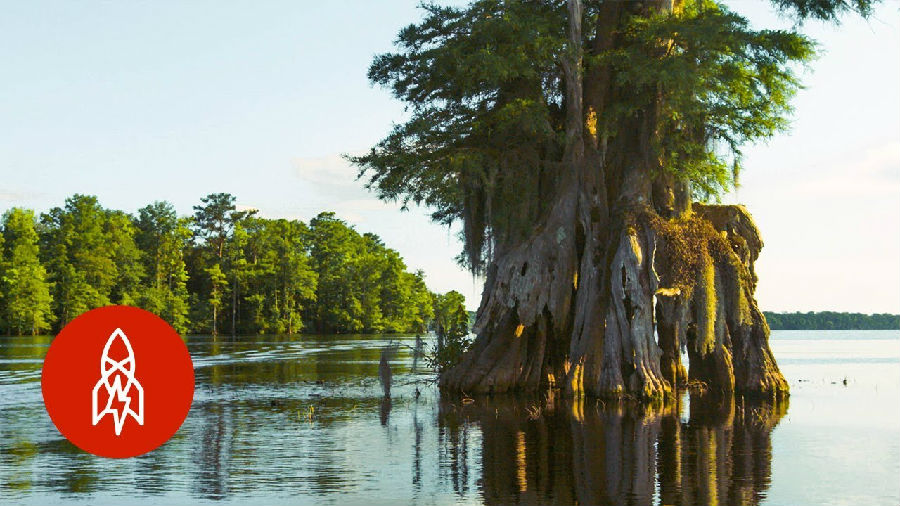The Dismal Swamp is an environment that has hazardous conditions associated with it.
迪斯默尔沼泽是个非常危险的地方。
The heat.
这里气温很高。
You got poisonous snakes and mosquitoes come out at certain times of the year and it's unbearable.
有些季节还会有毒蛇和蚊子出没,这里的环境简直让人难以忍受。
But when you think about some of the torture the enslaved peoples endured,
但当你想到奴隶们遭受的那些折磨时,
I think if most of us were living during that day and we had an option to go in the swamp and live freely,
如果我们中间的大多数人都生活在那个年代,并且可以选择去那片沼泽地自由地生活的话,
I think a lot of us would take that option.
我想,很多人都会做出那样的选择。
From the 17th century until the Civil War, escaped slaves, known as maroons, found refuge in the Great Dismal Swamp.
从17世纪到南北战争,逃跑的奴隶,人称“maroons”(逃亡的黑奴),纷纷躲到了大迪斯默尔沼泽。
Located on the border of Virginia and North Carolina, the swamp was wild and inhospitable.
该沼泽地位于弗吉尼亚州和北卡罗来纳州交界处,这是一片不宜住人的荒凉之地。
Nevertheless, it was there that runaways created self-sufficient communities almost entirely cut off from the outside world.
然而,就是在那里,逃亡的黑奴们建起了一个个自给自足并且几乎与外界完全隔绝的社会。
For the past 10 years, archaeologist Dan Sayers from American University has been studying these settlements.
过去10年里,美国大学的考古学家丹·塞耶斯一直在研究这些安居点。
"Part of what I did was develop this sort of research program called the Great Dismal Swamp Landscape Study.
“我的研究内容包括我发起的一项名为‘迪斯默尔沼泽景观研究’的研究项目。
Most of my focus has been on archeological discovery of sites out in the swamp as well as historical research and then, of course, trying to understand it.
我的研究主要集中在沼泽地的考古发现以及历史研究方面,其次就是试图去理解它。
Before we started our research, there was a sense people lived in the swamp for a variety of reasons
开始研究之前,我们有种人们是出于很多原因才选择住在那片沼泽地的感觉,

but we really wanted to go in the swamp and find remnants of their lives out there.
但我们是真的很想亲自进入沼泽地,去看看他们留下的蛛丝马迹。
And sure enough, we've been able to look at several sites associated with several of these different groups.
当然了,我们也考察了与某些群体相关的几个遗址。
Probably an 1790 to 1825 or '30 nail that we found in one of the resistance community settlements.
我们在其中一个反抗社区安居点找到了一枚可能属于1790年至1825年或1830年的钉子。
I'm sure the population went up and down,
我敢肯定,住在那里人口规模有过波动,
but very strong potential for any given moment for thousands of people that went out into the Great Dismal and formed these multi-generational communities.
然而,很有可能一直都有成千上万的人逃去那里然后创建出多代聚居的社区的。
It was a radical form of resistance in a good way."
这是一种非常极端的反抗方式,但也是一件好事。”
The runaways who escaped slavery risked everything to be free. Even if it meant living in the harsh environment of the swamp.
逃离奴隶制的人们为了自由甘冒任何风险。即便要他们生活在环境恶劣的沼泽地里他们也在所不惜。
One former slave who briefly lived in the swamp was a man named Moses Grandy.
摩西·格兰迪是一位曾在沼泽地短暂居住的前奴隶。
"I've done family genealogy research in which I've uncovered a slave narrative by Moses Grandy, who I believe is my great great grandfather's uncle.
我做过家族谱系研究,期间还发现了摩西·格兰迪讲述奴隶生活的史料,他应该是我的曾曾祖父的叔叔。
This is Edmond Grandy, my great great grandfather's headstone, who was born in 1827.
这是我曾曾祖父埃德蒙·格兰迪的墓碑,他出生于1827年。
He was a waterman and a boatsman on the Dismal Swamp Canal, which was being hand dug.
他是当时正纯手工开凿的迪斯默尔沼泽运河上的一名水手和船员。
And he describes very vividly in the slave narrative how they were treated, what they endured, how they were tortured.
他在作品中非常生动地讲述了他们是如何被对待的,他们忍受着怎样的遭遇以及受到了怎样的折磨。
If you had that kind of experience and you had an opportunity to come out to the swamp and live freely under, you know, challenging conditions,
如果你也有那样的经历,并且有机会逃出来到环境残酷的那片沼泽地里自由地生活,
you're gonna have a hard time getting them out of there.
你就很难把他们从那里再弄出来。
The idea of Africans setting up communities and being in charge of their destiny in the swamp,
他们的理念就是非洲人在沼泽地建立社区并掌握自己的命运,
I don't want people to ever forget this history.
我希望人们永远也不要遗忘这段历史。


